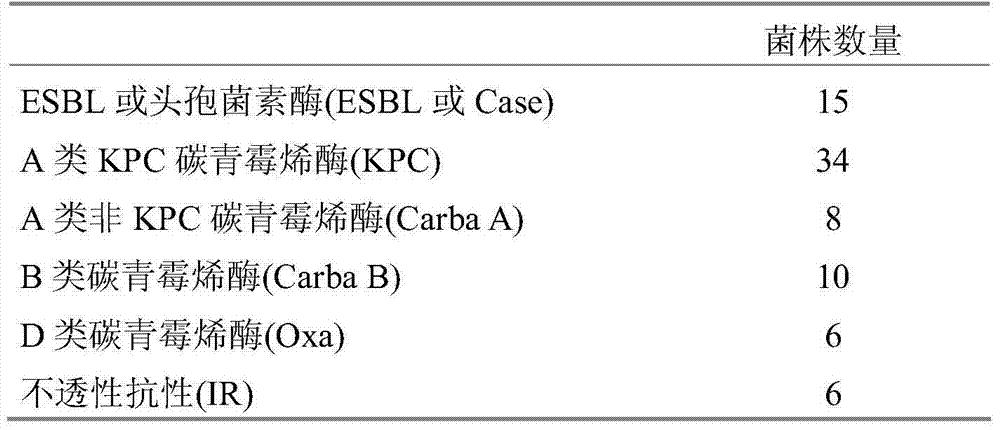Detection of bacteria having a resistance to carbapenems
A technology of carbapenems and bacteria, applied in the field of detection of bacteria resistant to carbapenems
- Summary
- Abstract
- Description
- Claims
- Application Information
AI Technical Summary
Problems solved by technology
Method used
Image
Examples
Embodiment 1
[0056] Example 1 Testing Faropenem on Pure Strains
[0057] 1. Media and Microorganisms
[0058] 79 strains of Gram-negative bacteria were tested on medium containing different concentrations of faropenem, of which 69 strains were enterobacteria and 10 strains were non-enterobacteria (non-fermenting bacteria), and their resistance characteristics were listed in Table 1, to establish the sensitivity / specificity of each preparation. Plates were read after 24 hours of incubation at 37°C.
[0059] Table I: Characterization of the resistance mechanisms of the tested strains
[0060]
[0061] The medium used was regular agar medium containing at least one chromogenic substrate supplemented with faropenem at the following concentrations:
[0062]
[0063] 2. Test
[0064] Divide the medium into 120X120 square dishes.
[0065] Inoculations were performed from 24-h pre-cultures on trypcase soybean agar at 37 °C.
[0066] For each strain, a 0.5 McF suspension in physiologica...
Embodiment 2
[0079] Doripenem test on the pure strain of embodiment 2
[0080] 1. Media and Microorganisms
[0081] 100 strains of Gram-negative bacteria were tested on media containing different concentrations of faropenem, 98 of which were enterobacteria and 2 strains were non-enterobacteria (non-fermenting bacteria), their resistance characteristics are listed in Table III, to establish the sensitivity and specificity of each preparation. Media containing 0.125 mg / L meropenem were also tested. Chromogenic medium (Biorad) was used as a growth control. Plates were read after incubation at 37°C for 24h and 48h.
[0082] Table III: Characterization of the resistance mechanisms of the tested strains
[0083]
[0084] The medium used was a regular agar medium containing at least one chromogenic substrate supplemented with the following concentrations of carbapenems:
[0085]
[0086] 2. Test
[0087] Divide the medium into 90mm dishes.
[0088] Each strain was spot-inoculated on...
Embodiment 3
[0094] Example 3 Comparison of media containing doripenem with commercially available media
[0095] 1. Media and Microorganisms
[0096] In the medium B (0.065mg / L doripenem) and COLOREX described above T Of the 100 enterobacterial strains tested on MKPC medium, 25 of them produced carbapenemase, and their resistance characteristics are listed in Table V. The latter medium was supplied by BioMed Diagnostics Inc. and corresponds to CHROMagar TM KPC ready-to-use medium.
[0097] Table V: Characterization of the resistance mechanisms of the tested strains
[0098]
[0099] 2. Test
[0100] Use 1 μL (contains about 10 4 microorganisms) diluted 0.5McF suspension to inoculate each strain on each medium.
[0101] Readings were performed after 24 and 48 hours of incubation at 37°C.
[0102] 3. Results and Interpretation
[0103] Table VI: Percentage of strains developed on medium
[0104]
[0105] Media containing 0.065 mg / L doripenem allowed growth of 92% of carbapene...
PUM
 Login to View More
Login to View More Abstract
Description
Claims
Application Information
 Login to View More
Login to View More - R&D
- Intellectual Property
- Life Sciences
- Materials
- Tech Scout
- Unparalleled Data Quality
- Higher Quality Content
- 60% Fewer Hallucinations
Browse by: Latest US Patents, China's latest patents, Technical Efficacy Thesaurus, Application Domain, Technology Topic, Popular Technical Reports.
© 2025 PatSnap. All rights reserved.Legal|Privacy policy|Modern Slavery Act Transparency Statement|Sitemap|About US| Contact US: help@patsnap.com



